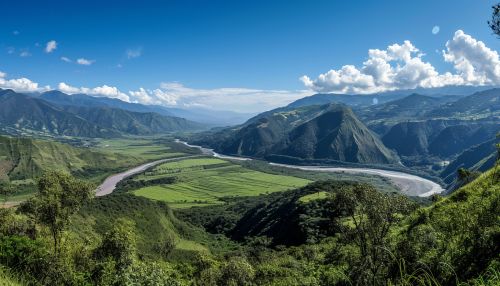Ecuador
Geography
Ecuador, officially known as the Republic of Ecuador, is a country located in the northwestern part of South America. It is bordered by Colombia to the north, Peru to the east and south, and the Pacific Ocean to the west. The country also includes the Galápagos Islands in the Pacific, about 1,000 kilometers west of the mainland.


Ecuador is one of 17 megadiverse countries in the world according to Conservation International, and it has the most biodiversity per square kilometer of any nation. It has 46 different ecosystems, from Tropical Rainforest, to Gobi Desert, to Glacial, spread across four main geographic regions: The Andes Mountains, the Amazon Rainforest, the Coast, and the Galápagos Islands.
The Andes
The Andes or Andean Mountains run north to south through Ecuador, effectively splitting the country into three distinct geographical areas: La Costa (the Coast), La Sierra (the Highlands), and El Oriente (the East). The Andes in Ecuador are divided into two parallel cordilleras (mountain ranges) that run the length of the country: the western range (Cordillera Occidental) and the eastern range (Cordillera Oriental). Between these ranges lies the central part of the country, a highland region known as the Interandean valley or "Avenue of the Volcanoes", home to eight of the country's ten highest peaks.
The Amazon Rainforest
The Amazon Rainforest in Ecuador, also known as El Oriente, covers the eastern part of the country. This region is part of the larger Amazon Basin, which is shared by eight countries. The Ecuadorian Amazon is known for its rich biodiversity and is home to many unique species of flora and fauna, as well as several indigenous tribes.
The Coast
La Costa, or the coastal region, is the low-lying area in western Ecuador that extends from the Andean foothills to the Pacific coast. The region is characterized by its tropical climate, fertile plains, and beautiful beaches. It is also the country's main agricultural region, producing a large portion of Ecuador's export goods.
The Galápagos Islands
The Galápagos Islands are an archipelago of volcanic islands located in the Pacific Ocean. They are renowned for their unique ecosystem, which was instrumental in the development of Charles Darwin's theory of evolution by natural selection following his visit in 1835.
History
The history of Ecuador spans several millennia. The oldest artifacts discovered in the region, the Las Vegas culture pottery, date back to 8000–7000 BCE. Over the centuries, various indigenous cultures thrived in the area, including the Valdivia, Machalilla, Chorrera, and Guangala.
In the 15th century, the Inca Empire expanded into the area of present-day Ecuador. However, their rule was short-lived, as the Spanish arrived in 1531 and ultimately conquered the region.


Ecuador was a part of the Spanish Empire for nearly 300 years, during which time it was part of the Viceroyalty of Peru and later the Viceroyalty of New Granada. The struggle for independence began in 1809 and, after many battles and internal conflicts, Ecuador gained its independence from Spain on May 24, 1822.
In the post-independence era, Ecuador went through periods of political instability, territorial disputes, and economic crises. Despite these challenges, the country has made significant strides in recent decades, particularly in the areas of literacy, health care, and economic stability.
Economy
Ecuador's economy is the eighth largest in Latin America and the 69th largest in the world by total GDP. The country is classified as a medium-income country. Ecuador's economy is heavily dependent on exports, with petroleum accounting for more than half of the country's export earnings.
Ecuador is also the world's largest exporter of bananas (about 25% of global banana exports) and a major exporter of shrimp. Exports of non-traditional products such as flowers and canned fish have grown in recent years.
The country is a member of the Organization of Petroleum Exporting Countries (OPEC), and it has substantial petroleum resources. The oil sector plays a central role in the Ecuadorian economy: oil revenues represent more than 40% of the country's total export earnings and more than a third of public sector revenues.
In recent years, Ecuador has moved towards a more diversified economy, with the services sector accounting for nearly 60% of GDP. This includes areas such as finance, real estate, health, education, retail, and communication.
Culture
Ecuador's culture is a mix of indigenous, Spanish, and African influences. The country is known for its rich folklore, vibrant festivals, and distinctive regional cuisines.


Ecuadorian music ranges from traditional Andean music to tropical styles such as salsa and merengue. The country is also known for its visual arts, particularly its handicrafts and textiles.
Spanish is the official language of Ecuador, but Quichua – an Incan language – is spoken by the indigenous population. In addition, there are several other indigenous languages spoken in the country.
See Also
- Andean states
- Spanish colonization of the Americas
- Ecuadorian cuisine
- Music of Ecuador
- Economy of Ecuador
